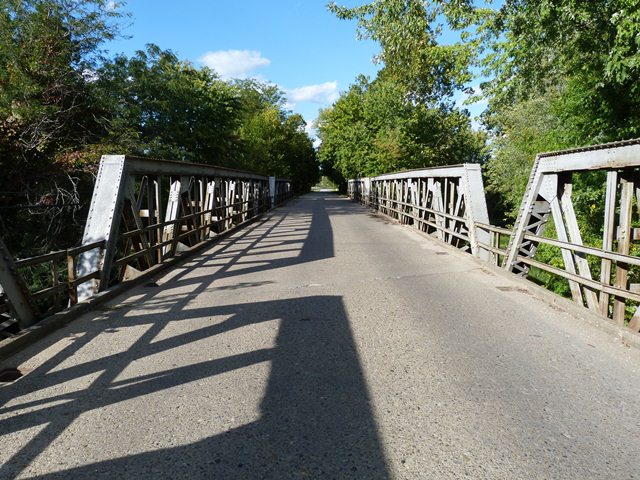We Recommend:
Bach Steel - Experts at historic truss bridge restoration.
BridgeHunter.com Phase 1 is released to the public! - Visit Now
Old IN-37 Bridge
Morgan County Bridge 224

Primary Photographer(s): Nathan Holth and Rick McOmber
Bridge Documented: September 23, 2012
Rural: Morgan County, Indiana: United States
1926 By Builder/Contractor: Vincennes Bridge Company of Vincennes, Indiana
Not Available or Not Applicable
77.0 Feet (23.5 Meters)
236.6 Feet (72.1 Meters)
19 Feet (5.79 Meters)
3 Main Span(s)
5500142

View Information About HSR Ratings
Bridge Documentation
View Archived National Bridge Inventory Report - Has Additional Details and Evaluation
This bridge is an early state standard plan truss bridge. It is noted for its multi-span design (uncommon among pony truss bridges) and its skewed orientation. The bridge is on old state highway alignment which is today a local road. The bridge retains good historic integrity with no major alterations.
Information and Findings From DHPA Historic Bridge SurveyStatement of Significance One of the state's longer structures of its kind to survive, the heavy-duty and unadorned spans are of standard design. The whole retains its integrity. Architectural Description Concrete abutments, wingwalls, and piers support the three-span Warren pony truss. The riveted structure extends 232' in seven panels for each span. The western trusses are offset about one panel to the south. The all-interior verticals are manufactured from pairs of angles riveted together with stay plates and reinforced with external sway bracing. The diagonals, growing increasingly lighter toward midspan, are made of a pair of angles (doubled in the outer panel) also riveted together with stay plates. The I floor beams are riveted to gussets and the verticals above the lower chord and carry the concrete deck with its 20' roadway. Other Information The Vincennes Bridge Company of Vincennes, Indiana, bid $27,558.47 to build this three-span skewed structure (30deg.L) on concrete abutments and piers in July 1925. The bid came in about seven thousand below the state engineers' estimate, although in the end Vincennes was paid two thousand dollars over its bid. The bridge was complete by July 1926. The ISHC relied on an early standard plan for 77-ft., riveted, half-hip, Warren pony-truss spans with 20-ft. roadways. The 8-ft. 9-in. deep trusses carry seven 11-ft. wide panels. The external sway braces share battens with the all-interior verticals--each of two pairs of angles (3.5"x2.5"Ls) riveted together. The diagonals are heavier towards the ends (4Ls@3.5x3) than toward midspan (2Ls@3.5"x2.5"), each member riveted together with battens. The upper and lower chord members, on the other hand, become increasingly heavier toward midspan. For the top, a pair of 10-in. channels grow from 15.3 lbs to 20 lbs. For the bottom, a single pair of angles (6"x3.5"Ls) serve in the outer panel; thereafter the pairs are doubled. The ISHC specified fairly heavy I-floor-beams (24"@79.9#). These were riveted to the verticals above the lower chord and to their sides were attached seven rows of rolled 10-in. Is (@25.4#) as stringers, together carrying the concrete deck. Angles supply the lower sway bracing. Post and channel guardrails line the trusses. This is probably the oldest extant state-design Warren pony-truss structures. It is multi-span, skewed, and retains its original members. A notable Indiana bridge builder fabricated and erected the trusses along with the substructure. Bridge Considered Historic By Survey: Yes |
![]()
Photo Galleries and Videos: Old IN-37 Bridge
Bridge Photo-Documentation
Original / Full Size PhotosA collection of overview and detail photos. This gallery offers photos in the highest available resolution and file size in a touch-friendly popup viewer.
Alternatively, Browse Without Using Viewer
![]()
Bridge Photo-Documentation
Mobile Optimized PhotosA collection of overview and detail photos. This gallery features data-friendly, fast-loading photos in a touch-friendly popup viewer.
Alternatively, Browse Without Using Viewer
![]()
Northbound Crossing
Full Motion VideoStreaming video of the bridge. Also includes a higher quality downloadable video for greater clarity or offline viewing.
![]()
Maps and Links: Old IN-37 Bridge
Coordinates (Latitude, Longitude):
Search For Additional Bridge Listings:
Bridgehunter.com: View listed bridges within 0.5 miles (0.8 kilometers) of this bridge.
Bridgehunter.com: View listed bridges within 10 miles (16 kilometers) of this bridge.
Additional Maps:
Google Streetview (If Available)
GeoHack (Additional Links and Coordinates)
Apple Maps (Via DuckDuckGo Search)
Apple Maps (Apple devices only)
Android: Open Location In Your Map or GPS App
Flickr Gallery (Find Nearby Photos)
Wikimedia Commons (Find Nearby Photos)
Directions Via Sygic For Android
Directions Via Sygic For iOS and Android Dolphin Browser
USGS National Map (United States Only)
Historical USGS Topo Maps (United States Only)
Historic Aerials (United States Only)
CalTopo Maps (United States Only)


